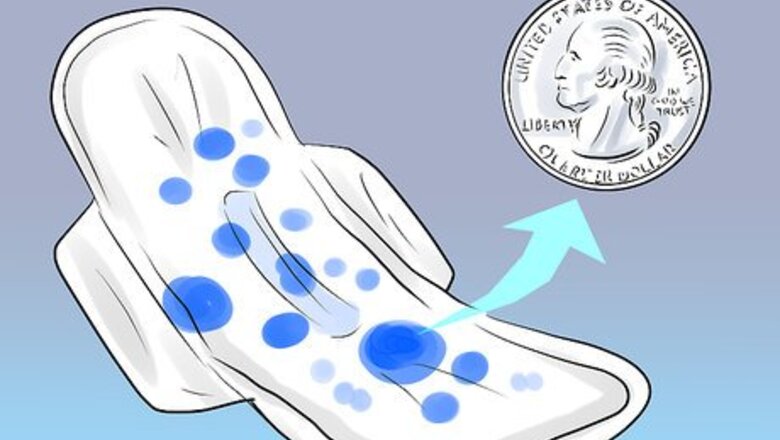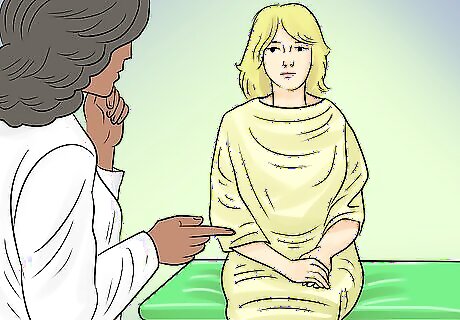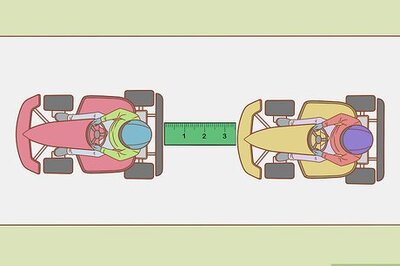
views
Diagnosing Heavy Bleeding and Clotting

Look for blood clots. One of the main signs of heavy bleeding (also called menorrhagia) is having blood clots in your flow. For this diagnosis, blood clots the size of a quarter or larger are considered to be connected to heavy bleeding. Check your pad, tampon, and the toilet for blood clots. Blood clots will look like regular menstrual blood, except they will be more solid, almost jelly-like. Smaller blood clots are normal, and you don't need to worry about them.

Notice how often you change your pad or tampon. If you're changing your pad or tampon more often than every 2 hours, you have what's known as heavy bleeding. Heavy bleeding can prevent you from doing things you love, if you're constantly worried about overflow. For instance, if you're changing your pad or tampon every hour (for several hours in a row) and its soaked each time, that's considered heavy bleeding.

Pay attention to the length of your period. Generally, periods last 3 to 5 days, though 2 to 7 days is also fairly normal. If your period is lasting longer than 10 days at a time (that is, if you're bleeding for that long), that is a sign that you're having heavy bleeding.

Look for cramps. Cramping can also be a sign of heavy bleeding. As noted, large blood clots are a symptom of heavy bleeding. These blood clots can be difficult to pass, causing heavier cramping. Therefore, if you notice heavy cramping, that could also be a sign of heavy bleeding.

Watch for the symptoms of anemia. Anemia is when you don't have enough iron in your blood. It often occurs in people who lose large amounts of blood. Usually, the main symptoms are tiredness and lethargy, as well as feeling weak. "Anemia" can actually refer to any type of vitamin deficiency, but generally, low iron is the most common when it comes to menstruation problems.
Talking to a Doctor

Make a list of symptoms. When you're going into a doctor, it's always best to be prepared. Make a physical list of the symptoms you've been experiencing. Try to be as specific as possible. Don't be embarrassed; your doctor has heard it all. For instance, you might write down, "heavier flow (on heavy days, bleeding through a pad every hour for 3 or 4 hours in a row), more cramping, blood clots the size of quarters, feeling weak and tired, blood flow lasting 12 to 14 days." It can help to count the number of pads or tampons you use while you're bleeding. It's also important to note any major changes in your life, such as big events that have caused you stress and sudden weight gain or loss. Ask around in your family to see if anyone else has similar problems, as menstrual problems can be genetic.

Ask about a blood test for anemia. If you think you may be suffering from a anemia, ask your doctor about having a blood test. A blood test can determine the level of iron in your blood. If you have low iron, your doctor will likely recommend increased iron in both your diet and the supplements you take.

Expect a physical examination. Usually, to help diagnose the problem, your doctor will want to conduct a physical examination, including taking a pap smear. A pap smear is when your doctor takes a small scraping of cells from your cervix to test for any problems. Your doctor may also take tissue from your uterus to biopsy. You may also need an ultrasound or a hysteroscopy. With a hysteroscopy, a tiny camera is threaded into your uterus through your vagina, allowing the doctor to look for problems.
Treating Heavy Bleeding and Clotting

Ask about taking NSAIDs. NSAIDs are a class of pain medications that include ibuprofen and naproxen. They can help with the pain associated with heavy bleeding. However, they can also decrease the amount of blood you lose during your period, which may help with clots. However, when taking an NSAID, watch for an increase in bleeding, as it can be a side effect for some people.

Consider getting on oral contraceptives. Doctors often prescribe oral contraceptives in cases where patients are having periods with heavy bleeding. Oral contraceptives can make your periods more regular, but they can also decrease the amount you bleed overall, which in turn can decrease blood clots. Oral contraceptives can help because heavy bleeding and blood clotting is sometimes caused by hormonal imbalances. Oral contraceptives help balance out the hormones in your body. Other types of hormone pills can also be effective, such as a progesterone-only pill, as well as some intrauterine devices that release hormones.

Talk about tranexamic acid. This medication can help reduce the blood flow while you are on your period. You only take it when you're bleeding, not the rest of the month like contraceptives. With less bleeding, you'll get fewer blood clots.

Discuss surgery if other options don't work. If medications don't help your problem, surgery may be an option. In a dilation and curettage, commonly known as a D&C, your doctor takes away the top layer in your uterus, part of the lining, which can help with bleeding and clots. In an endometrial ablation or resection, more of the uterine lining is removed. Another option is an operative hysteroscopy, where your doctor will view the inside of your uterus with a small camera, then take out any small fibroids and polyps, as well as work on any other problems, which can also decrease bleeding. Finally, you can have a hysterectomy, where your uterus is removed completely.




















Comments
0 comment